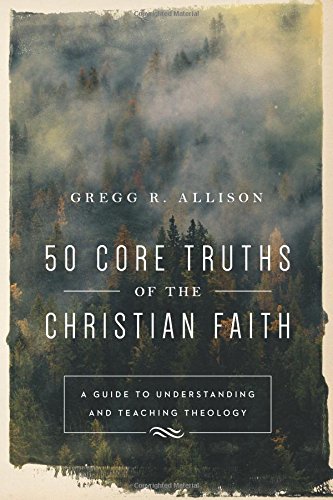Dr. Gregg Allison is professor of Christian Theology at The Southern Baptist Theological Seminary in Louisville, KY. He has been teaching theology for a good many years, and now he’s put some of it in print in his new 50 Core Truths of the Christian Faith: A Guide to Understanding and Teaching Theology. And his intent is not just to teach you theology: he wants to help you teach theology too!
I’m Fred Zaspel, editor here at Books At a Glance, and I have Dr. Allison with us to talk to us about his new book.
Gregg, welcome, and congratulations on your new book!
Gregg Allison:
Thank you, Fred; thank you for having this conversation with me.
Zaspel:
Okay, there are lots of books on Bible doctrine, so let’s talk about the niche you’re hoping to fill. How is your book different?
Allison:
It is a user-friendly guide, to quote the subtitle, a Guide to Understanding and Teaching Theology. The goal is to help readers learn theology for themselves and then also be in a position to be able to communicate it to others. There are 50 core truths, 50 of the essential doctrines of the Christian faith. Each one is covered in exactly 7 pages. For those of your listeners who want to know, that’s 2200 words per doctrine, so it’s really lean and really concise. It’s doctrines that I think, from my perspective, should be believed and practiced, confessed by the church, and taught by the church.
Zaspel:
Wow, you’ve really honed that down – 2200 words each!
Allison:
Almost exactly, for every chapter.
Zaspel:
That’s really good; that’s quite an accomplishment.
So your intended audience, then, is who?
Allison:
A variety of people – pastors who want to have a basic outline, in case they want to do doctrinal sermons like on the Incarnation or the Trinity; Sunday school teachers who are teaching basic Christian doctrine; small group leaders who may be called upon to work through doctrinal matters, misunderstandings in their community groups and their mission groups; Christians who are doing catechism classes in churches; classes for leaders in training; and also, then, for Christian schools where they are doing basic doctrine classes. That’s the intended audience.
Zaspel:
Maybe you can give our listeners a brief glimpse at what they will find. Give us an overview of the book as a whole, and then tell us how the chapters themselves are laid out.
Allison:
After a brief introduction in which I talk about doctrine to be believed, practiced, confessed and taught, I treat 50 essential doctrines, 50 core doctrines. And this is how each chapter is laid out – I start with a summary statement, one sentence, a definition of the doctrine. Then, I do main themes, some key affirmations that must be made with regard to this doctrine. Some five, six, or seven affirmations, bullet pointed. Then I do a list of key Scriptures that support the doctrine. It’s a list of passages so if someone is preaching or teaching through those passages, they can refer to the chapter and, if they want to go into more depth about the doctrine that is taught in those verses. Then there is a section on understanding the doctrine. I narrate the major themes; I describe what the themes are; and, I also provide biblical support, I discuss the biblical passages in support of each doctrine. And then I talk about major errors to avoid. So, heresy – you do not want to affirm these things, you don’t want to teach these matters. For example, if you’re talking about the Trinity or the Incarnation, these are major errors to avoid. I then move into enacting the doctrine. So, living the doctrine, both for us as individual Christians as well as how we live out these doctrines in our churches. And then, how to teach the doctrine. How to not only go through the biblical material, but, for example, on the doctrine of baptism, why don’t you go to a baptismal service, observe it, and then talk about it; similarly for the Lord’s supper; similarly for worship. Observe baptism, the Lord’s supper, worship, and then discuss the doctrine behind those matters. I also have a section, perennial questions and problematic issues, told from the point of view of someone who would be in the audience of your teaching. These would be questions they’re going to have, the problematic issues they’re going to raise. For example, ‘the doctrine of the Trinity is just impossible to understand.” Or, “why does God create a world in which there is evil?” So, to tip off the teachers, these are going to be the questions and issues that will inevitably be raised as you cover this doctrine. And then I give a teaching outline, five or six points, how to teach this doctrine and I provide resources for them to consult to go deeper into each of the doctrines. For example, I have references in the Evangelical Dictionary of Theology, Grudem’s Systematic Theology, Erik Thoennes’s Life’s Big Questions. So, if they want to do more study, here’s seven different references that they can turn to. In addition to their denominational teachings and major monographs that they would consult, here’s some other basic sources.
Zaspel:
I’ve got to say that’s really a good idea. It’s not just content oriented, but it’s pedagogically oriented, helping the teachers. Great idea!
Maybe it would be helpful if you would pick a chapter, a doctrine, and give us an overview.
Allison:
Let’s do Chapter 11, the Trinity. I have a summary statement: the one true God is triune, or three in one, eternally existing as the three persons of Father, Son, and Holy Spirit. So, it’s just a one sentence summary. Then I talk about main themes and I talk about there being one God; I talk about three persons, each of whom is fully God; I talk about the economic Trinity and the ontological Trinity, just very basic affirmations. Then I have key Scripture like Genesis 1:26, “let us make man according to our image, according to our likeness.” Matthew 28:19, baptism into the name of the Father and of the End of the Holy Spirit. So I’ve got key Scripture. Major affirmations – I work through what is the economic Trinity? What is the ontological Trinity? We talk about eternal generation and eternal procession just in a very basic way. I talk about the biblical support where we find the doctrine of the Trinity hinted at, in the Old Testament more fully disclosed than the New Testament. Major errors: you do not want to affirm that God is only one person; you do not want to affirm that there are three Gods; you do not want to deny the distinctions between the three persons, and so forth. And then, enacting the doctrine, I show how the doctrine of the Trinity distinguishes the Christian faith from all the other religions of this world. I emphasize how in our church our worship should be Trinitarian. And then I turn to teaching the doctrine of the Trinity, just some basic ideas. I talk about the weakness of analogies and things like that, but how we have already experienced God as triune. Even in our salvation as God the Father purposed and directed the Son to become incarnate; the Son, who died on the cross and is resurrected for our salvation; the Spirit who applies salvation to our life. I look at prayer – we pray to the Father in the name of the Son in step with the Spirit. So, our salvation is Trinitarian, our prayer life is Trinitarian, so we know the Trinity. Even though it’s a difficult doctrine, we know the Trinity. I do a basic teaching outline and then I give resources in these seven different books.
Zaspel:
Is that same procedure followed, then, with every doctrine?
Allison:
Every single one. Everyone is exactly the same
Zaspel:
In any book of Bible doctrine there are going to be topics to address on which Christians differ. How do you handle these? And maybe you can give us a few examples.
Allison:
I try to fairly represent and provide other support for each position. Obviously, I have a position on these doctrines, but I try to fairly represent other positions and I try to show how that position would support itself. For example, on the doctrine of Perseverance of the Saints and Assurance of Salvation, I talk about the two divergent positions. The Reformed and Calvinist view has a certain view of perseverance of the Saints and then following from that, a certain view of assurance of salvation. The Arminian view has a certain view of perseverance of the Saints and flowing from that, a particular view of assurance of salvation. Baptism – I note the disagreement regarding who is to be baptized, infants or believers. The disagreement regarding the proper mode – should we sprinkle, poor, or immerse? In the chapter on Gifts of the Spirit, I talk about purposes of the gifts: how do we identify our gifts; and then I talk about cessationism and continuationism, trying to fairly represent these different views and show how they are held and why they are supported.
Zaspel:
Have you been encouraged with the response you’ve seen so far? Maybe you can give us a glimpse of how others are already using the book.
Allison:
It was released three weeks ago and, from what I can tell, it’s doing very well. I’m particularly encouraged by bulk orders from churches who want to put the book in the hands of all their leaders, their pastors, their elders, their deacons, their Sunday school teachers. There is an order for 50 books by an interim pastor for his church. Another multi-site church ordered 100 books. My own church, Sojourn Community Church, has ordered 85. I think that’s a really good sign that the book is accomplishing the purpose with which I designed it – to get it into the hands of leaders so that they can understand and teach these theological truths.
Zaspel:
We’re talking to Dr. Gregg Allison, author of the new book, 50 Core Truths of the Christian Faith: A Guide to Understanding and Teaching Theology. This book really is what the subtitle claims – a clear introductory study of essential Christian doctrines that also provides helpful guidance for teaching others. We hope you’ll get a copy for yourself and several others for the teachers in your church.
Gregg, good to talk to you always, and thanks so much for your good work and ministry.
Allison:
Thanks, Fred, for your encouragement.

